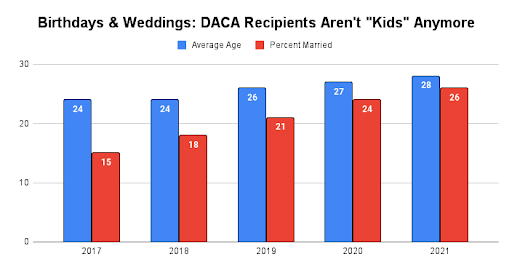Protecting Dreamers under the “Deferred Action for Childhood Arrivals” program created in 2012 has always made sense because they were brought here as children. For years, Dreamers were college students cramming for finals, young professionals starting their first jobs, or excited kids passing their driver’s tests.
But we’ve been bickering about a Dreamer solution for so long that many of those youths are now full-fledged adults. A decade has passed since the first group of DACA recipients was admitted into the program, and this year some are turning 40.
The latest data from the federal government confirms that the DACA program’s beneficiaries are ticking off major life milestones. Dreamers are getting married, buying houses, and having kids.
More than a quarter — 155,000 — of recipients are now married, and 12,000 have already divorced. At least 50,000 Dreamers married in the last five years, and tragically, nearly 500 are widowed.
A 2021 survey conducted by the Center for American Progress found that one-fifth of respondents 25 years and older have purchased their first home since receiving DACA status. That means tens of thousands have mortgages and contribute to local tax bases.
A sizable chunk of the Dreamer “kids” actually have kids themselves. The CAP survey found that nearly one-third of current DACA recipients have children — 99 percent of whom are U.S. citizens — rendering almost 200,000 DACA holders as parents.
When the DACA program started, less than a quarter of recipients were older than 25. The latest DACA data from the government, from September 2021, shows that nearly 30 percent are 30 or older, and the average age has reached 28.

This shift, from DACA holders as kids to adult parents, has significant implications for the Dreamers policy, especially given ongoing litigation. Withdrawing DACA protection would no longer hurt only the Dreamers; it would hurt bosses, spouses, and a new generation of kids. It would leave mid-career professionals jobless, and parents of U.S. citizens would be forced to leave the country.
The CAP survey found that 80 percent of respondents are employed, and a third are still in school. The precarious U.S. labor market, desperate for workers in nearly all sectors, couldn’t afford to lose hundreds of thousands of employees in the next few years. Moreover, because a court has blocked the program from accepting new applicants, this data is from September 2021, so beneficiaries are now even older.
The DACA program is in serious legal peril. In July 2021, U.S. District Judge Andrew S. Hanen of the Southern District of Texas ruled DACA unlawful, but temporarily stayed the part of his decision that would halt protections for current DACA recipients. The Biden administration is currently finalizing a new regulation to strengthen the legal basis of the DACA program. Still, many doubt that Judge Hanen will accept the Biden administration’s justifications, and he could terminate the program, rendering it likely that DACA will be back before the Supreme Court for a ruling in 2023.
DACA is certainly on questionable legal footing. Still, there is absolutely no doubt that the program has proved an enormous success for both recipients and their families and the U.S. as a whole. As a result of that success, we must revise and recognize that Dreamers are adults and are no longer youths. They are our colleagues, our children’s teachers, and fellow parents. The Dreamers are now peers, and we must commit to protecting them with the same fervor as when they were children.